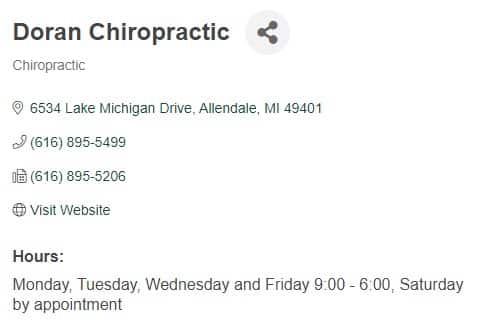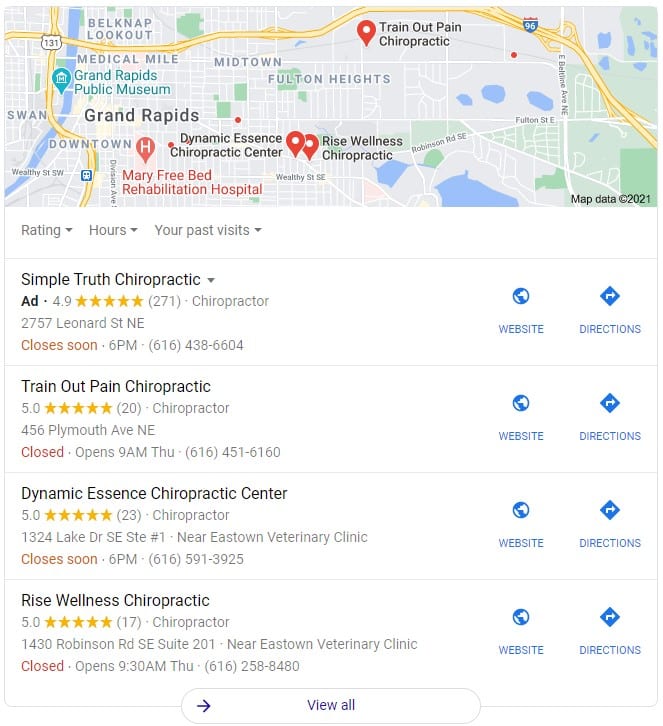Last Updated on April 20, 2022 by Adam Henige
Every chiropractor wants to get their rankings to the top of Google’s search results. When you’re at or near the top that means more web traffic which means more patients. But how do you make that happen? The answer? Search engine optimization. You likely get bombarded with emails and phone calls already with people trying to sell you these services. But before you go ahead and hire a company it’s good to know a little bit of background about how local chiropractor SEO works and how it pertains to chiropractors.
The fundamental elements of SEO for chiropractors
Google’s rankings for local businesses like chiropractors depend on three general factors.
- On site factors
- Off site factors
- Google My Business optimization
If this sounds like Greek to you, just hang in there. Let’s turn this into English.
On-site factors
These items are specific to your website. Most importantly, these are things you have control of, so there’s no excuse not to do a good job with these items. On-site factors include things like:
- Keyword usage. For example, if you want to rank out for “chiropractor in Savannah” – do you use the words “chiropractor in Savannah”? This is especially important in your page titles, which you can see in the tab at the top of your web browser.
- Technical SEO. Is your site structurally sound? Do the pages load quickly?
- Site usability. Is your site easy to navigate on a mobile device and a computer? Is information easy to find?
- Content quality. Do you provide high-quality, easy to read information? Is your text littered with grammar errors and misspellings?
Off-site factors
If Google only looked at on-site factors, everyone would just copy what the number one ranked chiropractor was doing and there would be no way to differentiate one site from the next. Google solved this factor and won the search marketing game by figuring out how to factor in signals from other websites.
What kind of signals? The first is links. When your chiropractic office gets a link from, say, the local Chamber of Commerce, Google takes notice. If you have that link and the competitor down the road doesn’t, that’s an advantage for you. Google looks at links from quality, relevant sites as a kind of vote of confidence that your site is trustworthy. The more quality sites that link to yours, the better you’re likely to rank. Below is an example of a link that Doran Chiropractic received from their local Chamber of Commerce in Allendale, Michigan. That “Visit Website” button links users to the Doran website.

The second signal is citations. What’s a citation? A citation is a reference to a business’s name, address, and phone number. The link above also includes a citation for Doran Chiropractic. Bonus! Below, you can see their citation on yellowpages.com, which also includes their name, address, and phone number. Google cross-references information like this to ensure that when they show you on their local map listings they have confidence that they’re providing an accurate business name, phone number, and address. This helps Google ensure they’re giving you good information, and that keeps you using Google.

Google My Business
When you do a local search for chiropractors in your area you’ll almost always see Google maps results, or what we call “the local pack”. Google offers a service called Google My Business where you can claim, create, and verify your business listing on Google Maps. Here, Google wants you to provide complete and accurate information so they can share it in these types of search results. You can include all of your citation information (make sure it matches!), images of your staff and the interior and exterior of your business, business hours, and much more. Provide as much detail as you can about your business so Google knows as much as they can about your office and they can pass it on to your visitors.

A DIY checklist for chiropractic SEO
Now that you’ve got a basic understanding of the elements that contribute to improving your search engine rankings, let’s walk through some items you can review on your own to see what kind of shape your SEO is in.
- Claim, complete, and verify your Google My Business listing
- Does your name, address, and local phone number match exactly from your website to your Google My Business listing?
- Does your home page title mention your target keyword and location? Check here
- Does your home page use your target keyword(s)?
- Is your website mobile friendly? Check here
- Are your citations consistent? Check here
- Do you have quality backlinks compared to the top ranking sites in your area? Check here
- Does your site meet Google’s page speed requirements? Check here
How did you do?
Once you’ve gone through the checklist you can begin to work on any fields that are lacking or incomplete. Some issues, like mobile-friendliness and site speed may require the help of a developer. However, even a novice can tackle issues on Google My Business and updating website copy. If you have questions about this checklist or need some professional help with your SEO please give us a call at 877.204.0234 or fill out our contact form.

Leave a Reply